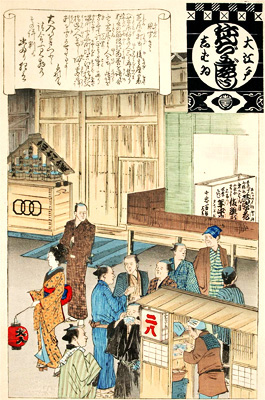Great-Edo Style
Great-Edo Fashion / Great-Edo GourmetThe Development of Food Service Industries
Being a castle town, from early on Edo boasted a large male population due to a strong samurai presence. This population was further reinforced by the sankin kōtai system. This system required that feudal lords (daimyō) travel regularly between Edo and their domains. The retinues of sankin kōtai and the remained samurai in Edo were all male vassals. Furthermore, as merchants who ran businesses in locations such as Osaka/Kyoto, Ise and Matsuzaka moved to Edo to establish branches in locations such as Nihonbashi, etc., they brought with them single male employees who added further to the city's male population. Indeed, this strong male representation within the city's demographics was the distinctive characteristics of Edo. To feed such people, a food service industry sprung up. Itinerant merchants called botefuri walked the streets of Edo selling their wares. There were also yatai (open-air food stalls) located here and there throughout the city.
(Seifūō Monouri Monomorai Zukushi)
[Painted by Shimizu Seifū]
(Ōedo Shibai Nenjū Gyōji Series Fūbunkiki)
Painted by Adachi Ginkō 1897 (Meiji 30)
After the "Great Fire of Meireki" (1657), in particular, Edo experienced huge labor influxes for reconstruction. To feed such people, dramatic increases were seen in the number of merchants who walked the streets. These merchants sold pre-prepared foods made of fish and vegetables, etc. Such merchants were known as niuri (sellers of cooked food) or yakiuri (sellers of grilled food). By the end of the Edo period, the city boasted many eating establishments that responded to the demands of the population, from tea houses and eateries that offered simple fare and sake to high-class restaurants. One reason why the food business thrived during the Edo period was that Edo was a society whose majority of residents were male.
* To view more explanation, please click the each image.





